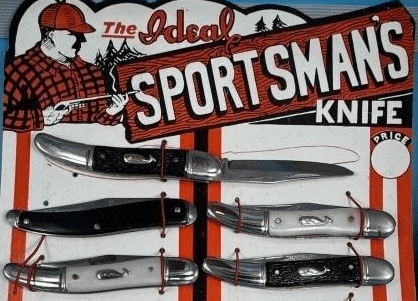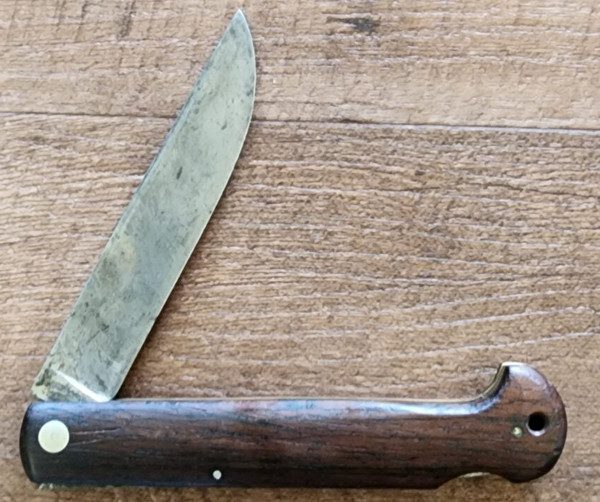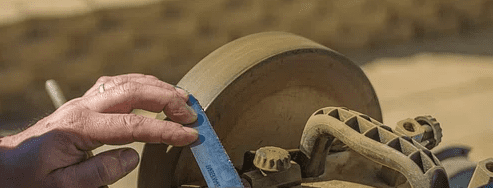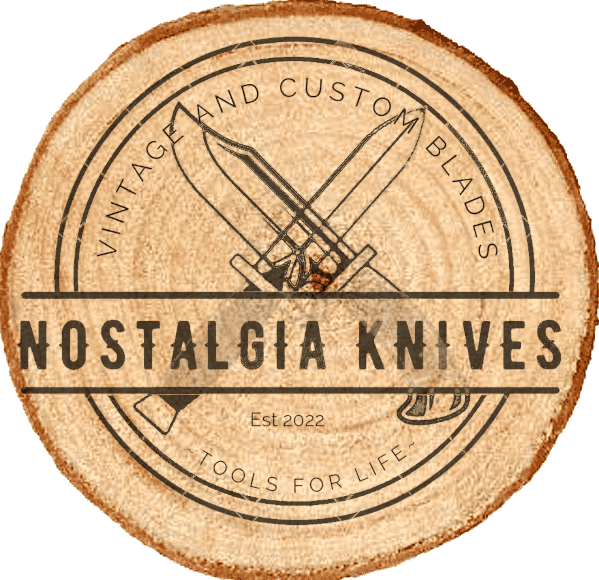The Ideal Knife Company: A Nostalgic Journey Through Counter-Top Pocket Knife Displays

Pocket knives were commonly sold in convenience stores and gas stations, often as impulse purchases or for convenience of those going out camping, or on a long road-trip to discover the outdoors.
Many knife manufacturers and distributors supply these stores with a variety of pocket knives to cater to customers looking for a compact and handy tool. And Ideal Knives is one of the most memorable of those cardboard counter-top displays that still exists in my own visions of yester-year.. =]
In the narrow aisles and check-out counters of the small convenience stores and gas stations of the old days, a humble yet iconic item has long held its place: the pocket knife.
Among the vast display of products competing for attention, pocket knives from companies like ‘Ideal Knife’ have litterally carved out their own niche.
The inexpensive pocket knives offering practicality, durability, and a hint of nostalgia at the check-out counter. Many of these blades are being passed down through the generations, and are still in use today.
Ideal Knives can be traced back to its roots in the early 20th century, when it began crafting pocket knives for everyday use.
With a focus on convenience, craftsmanship and utility, their knives soon found their way onto the countertops of convenience stores and gas stations across the country.
From urban centers to rural communities, these compact tools became a staple for anyone in need of a reliable blade on the go.
What sets The Ideal Knife Company apart is not just its presence in these ubiquitous retail locations, but also the enduring appeal of its products. Today, there’s a growing nostalgia for the pocket knives of yesteryear, with collectors eagerly seeking out vintage pieces from companies like Ideal. Many with mother of pearl type handle materials, they just visually stood out when displayed in an inpulse area of a store.
For many, these knives evoke memories of childhood adventures, camping trips, hiking trips, Whittling, or simply helping out with everyday tasks around the yard w/ Dad.
The simple act of folding out a pocket knife can transport someone back to a simpler time, when life moved at a slower pace and utility trumped flashiness. And back then, knives weren’t considered weapons, but rather just a sharp tool.
In the age of smartphones and high-tech gadgets, the enduring popularity of pocket knives speaks to a desire for authenticity and practicality. While newer, sleeker models may catch the eye, there’s something special about the well-worn handle of an old pocket knife, each scratch and scuff telling a story of its own.
For collectors, hunting down these vintage treasures has become a passion unto itself. Whether scouring flea markets, browsing online marketplaces, or swapping stories with fellow enthusiasts, the hunt for the perfect pocket knife is a journey filled with excitement and nostalgia.
In a world that’s constantly evolving, it’s comforting to know that some things remain unchanged. The humble pocket knife, with its timeless appeal and enduring utility, continues to hold its place on convenience store and gas station countertops. It’s a testament to the enduring legacy of companies like the old ‘Ideal’ Knife Company with merchandising displays that will live in many of our memories for a long time.
Especially those of us who still enjoy the nostalgia of these type of knives.
-NK
Using Smooth Rock to Sharpen Your Knife When Trying to Survive


In survival situations, a sharp knife can be the difference between life and death.
Whether you’re stranded in the wilderness or facing a crisis scenario, maintaining the sharpness of your blade is essential for cutting wood, preparing food, and crafting shelter.
While modern sharpening tools may not be readily available in such situations, nature provides a solution: smooth rocks.
In this article, we’ll explore the art of using smooth rocks to sharpen your knife when trying to survive, detailing various techniques and considerations for effectively honing your blade in the wild.

- Identifying Suitable Rocks: The first step in using smooth rocks to sharpen your knife is to identify suitable stones in your environment. Look for rocks with smooth surfaces and fine-grained textures, such as river stones, sandstone, or quartzite. These types of rocks are ideal for sharpening because they offer a consistent surface for honing and are less likely to damage your blade.
- Preparing the Stone: Before you begin sharpening, it’s essential to prepare the stone properly. If the rock is dirty or covered in debris, rinse it with water to remove any contaminants that could scratch your knife blade. Additionally, you may want to flatten the surface of the stone by rubbing it against another smooth rock or hard surface. This step ensures that you have a uniform sharpening surface to work with. If possible, soak the prepared stone in water for a short period.
- Finding the Right Angle: Achieving the correct sharpening angle is crucial for effectively honing your knife blade. While there is no one-size-fits-all angle, a good starting point is to match the existing bevel angle of your knife, typically around 15 to 20 degrees for most blades. Hold the knife at a consistent angle against the smooth rock, ensuring that you maintain this angle throughout the sharpening process.
- Using Circular Motions: One common technique for sharpening your knife with a smooth rock is to use circular motions. Start by placing the blade against the stone at the desired angle, then make small circular motions while applying gentle pressure. Continue this motion, working your way along the entire length of the blade, until you achieve the desired level of sharpness. Circular motions help evenly distribute the sharpening action across the blade, ensuring a uniform edge.
- Employing Long Strokes: Another approach to sharpening with a smooth rock is to use long, sweeping strokes along the length of the blade. Begin by positioning the knife at the appropriate angle against the stone, then draw the blade smoothly and steadily along the surface of the rock, from heel to tip. Repeat this motion several times, alternating sides to ensure even sharpening. Long strokes help remove any burrs or dull spots along the edge, resulting in a sharper blade.
- Checking for Sharpness: Throughout the sharpening process, it’s essential to periodically check the sharpness of your knife blade. You can do this by carefully running your fingertip along the edge, being cautious to avoid cutting yourself. A properly sharpened blade should feel smooth and even, with no noticeable nicks or dull spots. If you encounter any areas that still feel dull, continue sharpening until the entire edge is uniformly sharp.
- Honing the Edge: Once you’ve sharpened your knife blade to your satisfaction, you may want to further refine the edge by honing it with a smooth rock. Honing helps to realign the microscopic teeth along the edge, enhancing cutting performance and longevity. To hone the edge, simply make light, alternating strokes along the blade, using the same angle and motion as during sharpening. This final step ensures that your knife is razor-sharp and ready for use in any survival situation.

When faced with the challenge of sharpening your knife in a survival scenario, smooth rocks can be a valuable and effective tool. By identifying suitable stones, preparing them properly, and using the right techniques, you can maintain the sharpness of your blade even in the most rugged environments. Whether you’re stranded in the wilderness or preparing for a disaster, mastering the art of sharpening with smooth rocks is an essential skill for any survivalist. So, the next time you find yourself in need of a sharp edge, look to nature’s bounty and harness the power of smooth rocks to keep your knife in top condition.
Friction Folder Knife – DIY project approach..

A friction folder knife is a versatile and straightforward folding knife design that you can craft with basic tools and materials. In this step-by-step guide, we’ll walk you through the process of making your own friction folder knife. This DIY project is not only rewarding but also allows you to customize the knife to your liking.
Read MoreKnife Edge Grinds: Some Explanation and Description

Introduction
A crucial aspect of understanding knives and their performance is delving into the world of knife edge grinds. The edge grind of a knife refers to the shape of the blade’s cross-section, influencing its cutting ability, durability, and overall functionality. In this article, we will explore the various types of knife edge grinds, shedding light on their unique characteristics and applications.
Understanding the Basics
Before delving into the specific types of knife edge grinds, it’s essential to grasp the fundamental concepts. The edge grind is formed by shaping the bevel, the angled portion of the blade that extends from the spine to the cutting edge. The angle and geometry of this bevel significantly impact the knife’s performance in terms of sharpness, edge retention, and ease of sharpening.
Flat Grind;
The flat grind is one of the most common and versatile edge grinds. In this grind, the blade tapers from the spine to the cutting edge in a straight, flat manner. It allows for a sharp edge, excellent slicing performance, and ease of sharpening. Flat grinds come in different variations, including full flat grinds and high flat grinds, each offering unique advantages based on the intended use of the knife.
Hollow Grind;
Characterized by a concave curve on each side of the blade, the hollow grind creates a thin, razor-sharp edge. This type of edge grind is popular in straight razors and kitchen knives, offering exceptional slicing ability. The concavity reduces friction during cutting, making it ideal for tasks that require precision and control.
Convex Grind;
The convex grind features a smoothly curved profile that gradually slopes from the spine to the cutting edge. This type of grind is known for its strength and durability, making it well-suited for heavy-duty tasks. Convex edges are more challenging to sharpen than some other grinds but excel in tasks where robustness and edge stability are crucial.
Chisel Grind;
A unique grind that is prevalent in many traditional Japanese knives, the chisel grind has only one beveled side, with the opposite side being flat. This creates a sharp edge suitable for fine detail work. Chisel grinds are often used in woodworking tools and are easy to sharpen on one side only.
Scandi Grind;
The Scandi grind, also known as the Scandinavian or V grind, is characterized by a single, steep bevel that runs directly to the cutting edge. This grind is renowned for its simplicity and effectiveness in woodworking and bushcraft knives. The Scandi grind excels in tasks requiring controlled, precise cuts.
Saber Grind;
In a saber grind, the bevel starts above the midpoint of the blade, creating a strong and durable edge. This grind is commonly found in tactical and survival knives, providing a balance between slicing capability and durability. The added material near the spine enhances the blade’s strength, making it suitable for various challenging tasks.
Double Bevel Grind;
Also known as a compound bevel or double grind, this type features a primary bevel that transitions into a secondary bevel near the cutting edge. The double bevel grind is prevalent in many kitchen knives and offers a compromise between sharpness and durability. It provides excellent slicing performance while maintaining a degree of robustness.
Ad Link: Great Deals on Knife Grinder/Sharpening Equipment at Amz!
In conclusion, the world of knife edge grinds is diverse and fascinating, with each type serving a specific purpose based on the intended use of the knife. Whether you’re an outdoor enthusiast, a chef, or a collector, understanding the nuances of different edge grinds can enhance your appreciation for the craftsmanship behind each blade. The key lies in choosing the right grind for the task at hand, considering factors such as sharpness, durability, and ease of maintenance. As you explore the vast array of knives available, the knowledge of edge grinds will undoubtedly guide you towards selecting the perfect blade for your needs.
~
Flissa Knife Company
Introduction
In the realm of cutlery craftsmanship, Flissa Knife Company stands as a testament to the fusion of tradition and innovation. With a rich history dating back over a century, the company has become synonymous with quality, precision, and durability in the world of knives. This article delves into the fascinating journey of Flissa, tracing its roots, exploring its evolution, and highlighting the key milestones that have shaped its identity.
Origins and Early Days:
The story of Flissa Knife Company begins in the late 19th century when master blacksmith Samuel Flissa set up a small workshop in the heart of a bustling artisan district. Born into a family with a long-standing tradition of blacksmithing, Samuel inherited not only the skills but also a passion for crafting blades that transcended mere functionality.
| Ad: Shop for New Flissa Knives on Amz |
~As an Amazon Assoc. we earn a commission on qualifying purchases~
In those early days, the Flissa workshop primarily focused on producing utility knives for the local community. Samuel’s commitment to excellence and meticulous attention to detail quickly gained the attention of discerning customers, setting the foundation for what would eventually become an iconic brand.
Expansion and Innovation:
As the demand for Flissa knives grew, the company embraced technological advancements without compromising the essence of handcrafted excellence. In the early 20th century, the introduction of steam-powered machinery allowed Flissa to scale up production while maintaining the quality that had become synonymous with its name.
The company’s commitment to innovation was exemplified by the development of the “Flissa Edge,” a proprietary sharpening technique that enhanced the cutting performance of its blades. This unique edge became a hallmark of Flissa knives, distinguishing them from competitors and earning the trust of professional chefs and outdoor enthusiasts alike.
Weathering Challenges:
The mid-20th century brought about significant challenges for Flissa Knife Company. Economic downturns and shifts in consumer preferences tested the resilience of the brand. However, under the leadership of Samuel Flissa’s descendants, the company weathered these storms by adapting to changing market dynamics.
During this period, Flissa diversified its product line, introducing specialized knives for different purposes, including hunting, fishing, and camping. This strategic move not only expanded the brand’s appeal but also ensured its survival in a rapidly evolving industry.
Global Recognition:
The latter half of the 20th century witnessed Flissa Knife Company gaining international recognition. The company’s commitment to quality, combined with its dedication to preserving traditional craftsmanship, struck a chord with knife enthusiasts worldwide.
Flissa knives found their way into the kitchens of renowned chefs, the toolkits of adventurers, and the collections of collectors who admired both the aesthetic and functional aspects of these blades. The company’s global reach was further solidified through partnerships with distributors and collaborations with designers, propelling Flissa into the limelight as a leading name in the cutlery industry.
Adapting to the Digital Age:
As the 21st century unfolded, Flissa Knife Company embraced the digital age while staying true to its roots. The company launched an online platform, allowing customers to explore its extensive product catalog, learn about the intricate craftsmanship behind each blade, and connect with the Flissa community.
Social media became a powerful tool for Flissa to engage with its customer base, share stories of craftsmanship, and gather feedback. This digital presence not only enhanced the brand’s visibility but also served as a testament to its ability to evolve with the times without compromising its core values.
Legacy and Future:
Today, Flissa Knife Company stands as a living testament to the enduring legacy of craftsmanship, resilience, and innovation. The brand’s commitment to quality, coupled with a deep appreciation for the artistry of blade making, has solidified its place as a revered name in the cutlery world.
Looking forward, Flissa continues to innovate, incorporating modern materials and technologies into its traditional craftsmanship. The company remains dedicated to the principles laid down by Samuel Flissa, ensuring that each knife bearing the Flissa name is not just a tool but a testament to a legacy that spans generations.
In conclusion, the history of Flissa Knife Company is a captivating narrative of passion, perseverance, and precision. From its humble beginnings in a small blacksmith workshop to its current status as a global leader, Flissa’s journey reflects the timeless appeal of finely crafted blades and the enduring spirit of a family legacy that has stood the test of time.
|Shop for New Flissa Knives on Amazon.com |


